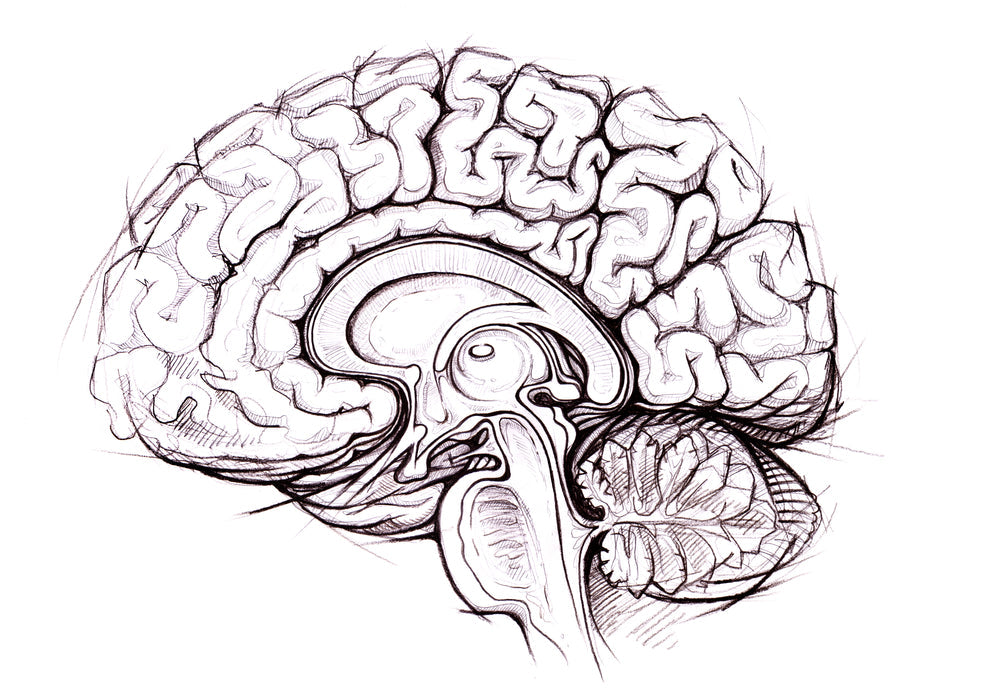
Electromagnetic field exposure can affect our mood, and can result in depression, anxiety, insomnia, lapses in attention and memory, and other brain and nervous system related symptoms. This is becoming very well known, as the science accumulates and breakthroughs in understanding are made. In fact, these are some of the first and most obvious symptoms of EMF harm. Many electrically hypersensitive people have strong neurological symptoms in the presence of high levels of EMFs, which can sometimes be debilitating.
Is there a reason that these types of symptoms are so commonplace, and are often the first noticeable EMF effects for many people? Yes! It’s related to the electrical nature of our brain and nervous system.
The human brain and nervous system are extraordinarily sensitive to electrochemical signals. This is by design, as our brain and nervous system function are completely dependent on electrical impulses to initiate a cascade of neurotransmitters and neuroendocrine hormones. These endogenous (produced by the body itself), highly electrosensitive chemical messengers control our mood, brain function, attention, memory, learning ability, motor function, hormone production, and many other essential functions that maintain the body’s optimal state on a daily basis.
The body’s electrochemical system utilizes ionic minerals, which alter their charge in response to how our sensory neurons perceive and respond to external cues (such as light, movement and heat), eliciting electrical changes in the cell membranes. These changes trigger voltage sensors in one or more of the voltage-gated ion channels, which are like guardians of the cell membranes, to open their gates and allow minerals to enter the inside of the cell to perform the appropriate function.
The groups of voltage-gated ion channels are each ideally controlled by one specific ionic element. Many are controlled by potassium, a few by sodium, some are chloride channels, and some are controlled by calcium. Ions have electrical effects within the body, and each voltage-gated ion channel has its own job to do.
Extensive research done by Dr. Martin Pall, retired Professor of Biochemistry and Medical Sciences at Washington State University, indicates that the voltage-gated calcium channels specifically are most dramatically affected by external, manmade electromagnetic fields. According to research compiled and evaluated from hundreds of studies, the specific nature of the voltage-gated calcium channels (often abbreviated as VGCCs) makes them extraordinarily sensitive to the pulsed and polarized microwave/radiofrequency radiation emitted by wireless communications equipment.
Our neurons and their ionic messenger molecules are designed to respond to the subtle fields produced by our own bodies, and the natural electric and magnetic fields of the Earth. The polarized nature of the EMFs produced by alternating current (AC) electrical wiring, as well as the pulsations and polarization on the carrier signals of wireless communication systems (these pulsations are what carries the information transmitted from cell tower to cell phone), are said to be massively overstimulating the voltage-gated calcium channels all throughout our bodies, which are at their highest concentration in the brain and nervous system.
This would result in a flood of calcium entering our cells, potentially 24/7, triggering a chain reaction of inflammatory and highly damaging molecules… and the vast majority of this calcium channel flooding would be happening in our brain and nervous system, due to its high concentration of VGCCs.
Many of us feel the downstream effects of this raging internal storm, and as 5G density increases throughout the world, symptoms are amplified and people everywhere are awakening to the realization that this is actually affecting us.
Research on brain function and EMFs
There is already a large body of research on humans and animals showing effects of electromagnetic fields on brain function. All of these studies used low intensity fields, well under the current safety standards set by the FCC, and all well below the threshold of thermal (heating) effects of EMFs.
In most of the studies done, microwave radiation was shown to alter various neurotransmitters, which alters brain function and behavior. Acetylcholine, a neurotransmitter that heavily influences cognitive function, focus, attention and memory, was significantly reduced after exposure to microwave radiation, especially 2.45 GHz Wifi radiation. The endogenous opioid neurotransmitter systems were also affected. Both choline and endogenous opioid changes can impair spatial learning and memory.
A Russian document originally written in 1973 investigated rats exposed to non-thermal levels of microwave radiation, and reported that even though the nervous system is only about 2% of the tissue mass of the rodents, the majority of the severe changes from radiation exposure occurred there, suggesting that the nervous system is the most sensitive region of the body to the effects of EMFs of all the body’s tissues, followed by the heart and testes. Subsequent research on the voltage-gated calcium channels supports this, as the highest concentration of VGCCs is found in the nervous system, and considering the central role that the VGCCs play in neurotransmitter and neuroendocrine hormone release. Another finding is that neuroendocrine hormones often increase in the initial period of exposure, but with prolonged exposure, the hormone supply becomes exhausted, leading to lowered secretion and sometimes cell death. The document also reports seizures, neurodegeneration, and synaptic connection disruptions, the last of which commonly occurs in cases of autism.
A NASA document from 1981 on non-thermal, non-ionizing electromagnetic field effects on humans reported occupational exposures to radio- to microwave-frequency EMFs resulted in headaches, fatigue and daytime sleepiness, sleep disturbances, memory loss, inability to concentrate, central nervous system disorders, extreme irritability, moodiness and nervous tension.
A 2013 survey showed that owners of Smart meters reported adverse health effects that were not experienced until the Smart meter was installed. The most common effects reported were insomnia, tinnitus, head pressure, difficulty concentrating, memory problems, agitation, fatigue, dizziness, numbness, and burning/tingling skin. A 2014 Smart meter case study in Australia reported very similar adverse effects.
A 2009 study on rats found a reduction in brain levels of vitamins C and E, and an increase in lipid peroxidation, all indicators of oxidative stress and free radical activity after EMF exposure. Replenishing vitamin C and E, as well as supplementing with selenium and L-carnitine, was found to protect the brain from oxidative damage from the EMFs.
One study examined the effects of EMFs on the microglia, which are the immune cells of the nervous system that are normally activated by injuries and infections of the nerve tissue. Excessive microglia activation can damage nerve tissue, and lead to degenerative brain diseases like Alzheimer’s and Parkinson’s. They found that 2.45 GHz radiation activated the microglia, followed by an inflammatory response.
Another study recorded a stress response to non-ionizing Wifi frequency radiation in the hippocampus of rat brains, by observing significant changes in stress related genes, including heat shock proteins, apoptosis and DNA repair genes. In many studies, calcium channel flooding has been shown to significantly increase heat shock proteins.
There is a study that exposed ant colonies to Wifi routers, and showed almost immediate disturbed and erratic behavior, and the appearance of being sick. Normal foraging patterns didn’t resume until several hours after the exposure ended.
Rats were exposed to three frequencies commonly used by cell phones – 900 Mhz, 1800 Mhz and 2.45 GHz. Spatial orientation, learning and memory were impaired at all three frequencies, and the number of DNA strand breaks was significantly increased. At the 1800 Mhz and 2.45 Ghz frequencies, DNA damage also increased significantly. Another study replicated these results with rats, at the same frequencies.
Another Wifi frequency study with rats showed a significant increase in reactive oxygen species (ROS), reactive nitrogen species (RNS), lipid peroxidation, apoptosis, and oxidative damage of DNA and proteins. Learning and memory were detrimentally affected due to cell damage.
Takeaways from the science
The human brain and nervous system are incredibly complex, and the experiments elaborated on above are in no way implying that there are simple, uniform effects across the board. The brain has ways of adapting very quickly to environmental changes, in an attempt to maintain functional homeostasis. When the receptors for certain neurotransmitters are stimulated out of proportion to opposing systems, the number of receptors actually decrease to compensate for the excessive stimulation. This phenomenon occurs during the high level dopamine stimulation from excess social media and drug use, where the user’s dopamine receptor numbers (and receptor sensitivity) decrease to where the person no longer feels the same degree of pleasure from more gentle, natural stimulus like listening to music and exercising.
Another example is how consistent caffeine consumption binds to our adenosine receptors (in place of adenosine), so we don’t feel tired when we would ordinarily. To compensate for this, and get the rest that we need, the body increases the number of adenosine receptors, to give our endogenous adenosine molecules a chance to utilize their own receptors and make us feel appropriately tired/restful. This is why a sudden cessation of caffeine makes us unusually tired for a period of time – we initially still have those larger numbers of adenosine receptors, which the body then floods solely with adenosine in the absence of caffeine. If the lack of caffeine continues, the body will soon reduce the number of adenosine molecules to normal levels, and we will no longer feel excessively tired.
The brain expertly adapts to all kinds of inputs, maintaining homeostasis in circumstances that would otherwise throw us off-kilter. This happens in response to EMFs, as well. In many cases, there are immediate drops in neurotransmitter output, demonstrating an obvious impairment in brain function. In some cases, there’s an initial increase in the output of some neurotransmitters (seeming to imply beneficial or therapeutic effects), with an eventual drop to inadequate levels after continued exposure. That’s why longer exposure durations are so important, and studies only showing short term exposures are not necessarily showing us the whole picture, especially as it applies to our real world, very long duration exposures!
One simplistic argument of the “EMFs have no health effects” camp (which includes the telecom industry, of course, and the governmental bodies that supposedly regulate them) is that because some studies show therapeutic effects of EMFs, and other studies show harmful effects, that this can be “zeroed out” to mean no effects. This is laughably oversimplistic, and just plain wrong. What these seemingly contradictory results actually show is that there ARE effects, but that their conditions are as nuanced and complex as the human body and the living earth itself, and need to be treated with much more discernment and curiosity when approached in research. A lot has already been revealed by the large body of EMF science, and a lot more remains to be fully understood.
One interesting theory, with some good evidence to back it up, is that the stimulation of the calcium channels can initiate one of two separate pathways, depending on the nature of the EMFs, including the frequency, intensity, and the duration of exposure. The first pathway is called the nitric oxide signaling pathway, with downstream effects of activating Nrf2, which has whole-body cell protective, antioxidant, anti-inflammatory and lifespan lengthening effects. This may explain the therapeutic effects of some types of EMFs – short exposure durations are more commonly associated with beneficial effects, but it is more nuanced than that. Nrf2 can also be activated by various antioxidant-rich food substances, such as berries, green tea, chocolate, onions, and other fruits.
The other pathway that can result from calcium channel activation is called the peroxynitrite pathway, which seems to be most reliably initiated by prolonged, excessive calcium signaling. This is thought to be the pathway of the pathophysiological (harmful) effects of EMFs. This pathway is characterized by elevated levels of both nitric oxide and superoxide, which react with each other to produce peroxynitrite. Peroxynitrite breaks down into free radicals, producing oxidative stress and potentially DNA damage, which adversely affects the body as a whole. Evidence suggests that longer duration exposure to certain types of EMFs, beyond a certain threshold, activates this destructive pathway.
Our own research (which Blushield EMF protection technology is based on) supports this, indicating that prolonged exposure to the repetitive frequencies from manmade EMF sources overstimulate the body and trigger the immune system, producing excessive oxidative stress.
Conclusion
Our intention with this article is to give you a glimpse into how much research has already accumulated related to the effects of electromagnetic fields on the function of human and animal brains and nervous systems... and also, how there is much more research that needs to be done!
The telecom industry views a lack of 100% conclusive evidence and debated mechanisms of harm as free reign to expose the population to any amount of radiation it wishes, with basically an “innocent until proven guilty” stance. We see it in exactly the opposite way – any shred of uncertainty regarding the extent of potential health harm should invoke the precautionary principle:
Precautionary principle (noun): “The principle that the introduction of a new product or process whose ultimate effects are disputed or unknown should be resisted.”
“The precautionary principle is a broad epistemological, philosophical and legal approach to innovations with potential for causing harm when extensive scientific knowledge on the matter is lacking. It emphasizes caution, pausing and review before leaping into new innovations that may prove disastrous.” – Wikipedia
Caution and skepticism regarding the unchecked proliferation of wireless radiation is a healthy mindset to have, and aligns with our natural protective instincts concerning the health of our own bodies and our family and friends we care for.
Safe, intelligent use of technology, plenty of distance and time away from devices (when possible), a nutrient-rich healthy diet, and effective EMF protection like Blushield home and portable devices is a sensible approach to take as the science works diligently to discover more about this novel influence in our modern lifestyles!
References:
- Study review: “Microwave frequency electromagnetic fields (EMFs) produce widespread neuropsychiatric effects including depression” – https://www.sciencedirect.com/science/article/pii/S0891061815000599
- Study review: “Wi-Fi is an important threat to human health” – https://www.sciencedirect.com/science/article/pii/S0013935118300355
- Study review: “Neurological Effects of Radiofrequency Electromagnetic Radiation” – https://mapcruzin.com/radiofrequency/henry_lai2.htm & https://link.springer.com/chapter/10.1007/978-1-4615-2542-4_2
- Study review: “Biological and pathological effects of 2.45 GHz radiation on cells, fertility, brain, and behavior.” – https://www.emfdata.org/en/documentations/detail?id=223
- Study review: “Electromagnetic field activation of voltage-gated calcium channels: role in therapeutic effects” – https://www.tandfonline.com/doi/full/10.3109/15368378.2014.906447

